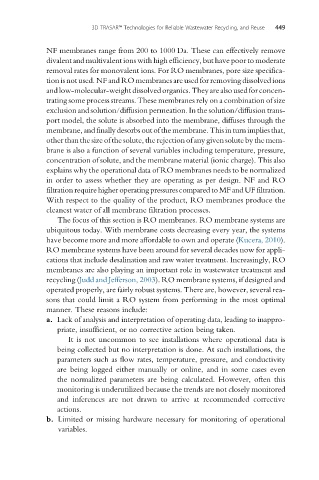Page 479 - Industrial Wastewater Treatment, Recycling and Reuse
P. 479
3D TRASAR™ Technologies for Reliable Wastewater Recycling, and Reuse 449
NF membranes range from 200 to 1000 Da. These can effectively remove
divalent and multivalent ions with high efficiency, but have poor to moderate
removal rates for monovalent ions. For RO membranes, pore size specifica-
tion is not used. NF and RO membranes are used for removing dissolved ions
andlow-molecular-weightdissolvedorganics.Theyarealsousedforconcen-
trating some process streams. These membranes rely on a combination of size
exclusion and solution/diffusion permeation. In the solution/diffusion trans-
port model, the solute is absorbed into the membrane, diffuses through the
membrane,andfinallydesorbsoutofthemembrane.Thisinturnimpliesthat,
other than the size of the solute, the rejection of any given solute by the mem-
brane is also a function of several variables including temperature, pressure,
concentration of solute, and the membrane material (ionic charge). This also
explains why the operational data of RO membranes needs to be normalized
in order to assess whether they are operating as per design. NF and RO
filtration requirehigher operating pressurescompared toMF and UF filtration.
With respect to the quality of the product, RO membranes produce the
cleanest water of all membrane filtration processes.
The focus of this section is RO membranes. RO membrane systems are
ubiquitous today. With membrane costs decreasing every year, the systems
have become more and more affordable to own and operate (Kucera, 2010).
RO membrane systems have been around for several decades now for appli-
cations that include desalination and raw water treatment. Increasingly, RO
membranes are also playing an important role in wastewater treatment and
recycling (Judd and Jefferson, 2003). RO membrane systems, if designed and
operated properly, are fairly robust systems. There are, however, several rea-
sons that could limit a RO system from performing in the most optimal
manner. These reasons include:
a. Lack of analysis and interpretation of operating data, leading to inappro-
priate, insufficient, or no corrective action being taken.
It is not uncommon to see installations where operational data is
being collected but no interpretation is done. At such installations, the
parameters such as flow rates, temperature, pressure, and conductivity
are being logged either manually or online, and in some cases even
the normalized parameters are being calculated. However, often this
monitoring is underutilized because the trends are not closely monitored
and inferences are not drawn to arrive at recommended corrective
actions.
b. Limited or missing hardware necessary for monitoring of operational
variables.

